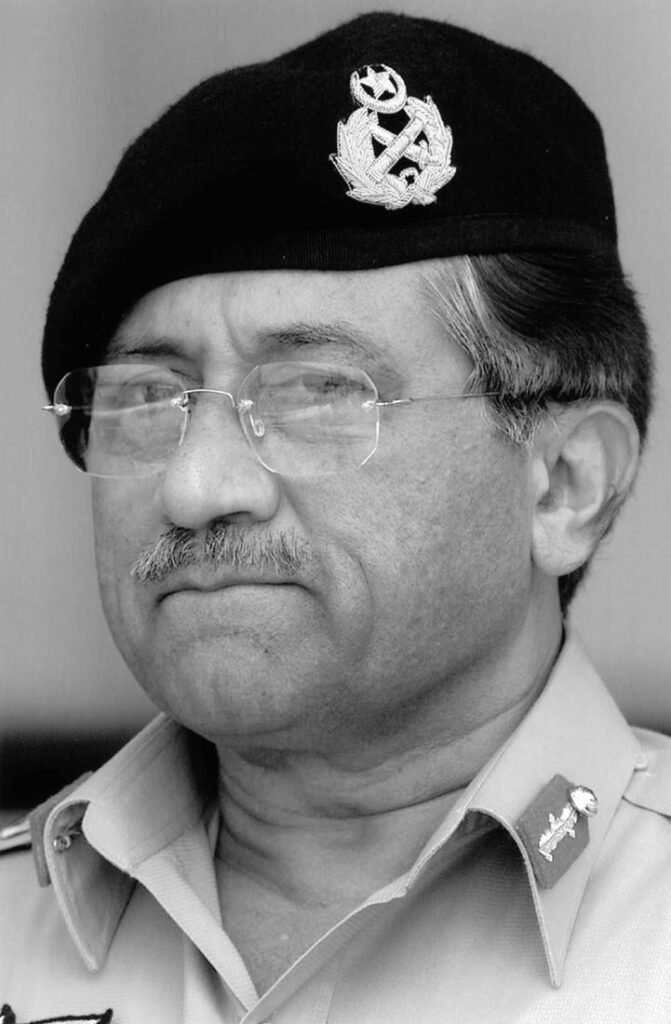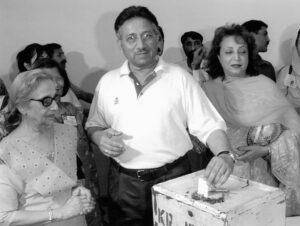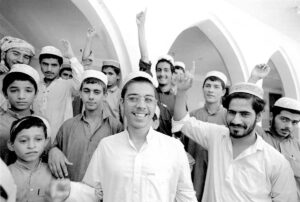With his country’s domestic and foreign policies largely buried in the wreckage of the World Trade Center and the Pentagon, General Pervez Musharraf, the military ruler of Pakistan, faced a stark choice: to align his country solidly behind the United States’ war against terrorism — the first battleground of which was just across his border in Afghanistan — or to be ostracized as the leader of a pariah state. In 48 hours in October, the 58-year-old general made his choice. He abandoned his country’s sponsorship of the Taliban, Afghanistan’s ruling student militia which Pakistan largely had spawned. He confronted tens of thousands of angry demonstrators on his streets, whose loyalties were not so much with Pakistan, as with the Taliban extremists and Osama bin Laden, Washington’s most wanted man. And then, to the surprise of many and the incredulity of most, he purged his army of the three key generals who had brought him to power less than two years before, as the leader of a cabal of fellow generals.

But no sooner had Musharraf committed himself to the United States than strains in the delicate relationship began to occur over the length of the U.S. bombing campaign and the composition of a broad-based government in Afghanistan to replace the Taliban. Presiding over an army that, over recent years, has become increasingly anti-American and fundamentalist, and over a nation which has produced some fifteen private Islamist armies — along with a nuclear arsenal in one of the most volatile regions of the world — the little-known enigmatic general was in the political epicenter of the unfolding storm. He was also a man on a tightrope, seemingly very much alone.
It had been a long journey from his native India, where he was born in August of l943 into a family of civil servants and socialists. India was still ruled by the British Raj. During the violent partition in 1947 that created the current Pakistan, at least a million people died as Hindus moved east, out of Pakistan, and Muslims moved west, into it. It was an event that affected Musharraf’s thinking for the rest of his life.
When I asked him, a few months ago, what he remembered most, about his family’s flight from New Delhi on the last train to Karachi 54 years ago, he didn’t answer immediately, and then he said, “A lot of tension. A lot of worry. A lot of fear. I also remember my father. He was carrying a small, metal box, about this size.” He measured a box with his hands. “It was full of money: 600 to 700,000 rupees, which was an immense amount of money at that time. It was given to him by the Foreign Office in Delhi where he’d served, and it was Pakistan’s share of the Foreign Ministry’s funds. He was guarding this little box with his life. He used to sleep with his head on it. And, when he was awake, he’d sit on it.”

General Musharraf had stood surrounded by aides as I entered his suite. A man of medium height and stocky build, he carried himself like a battle-hardened commando which, for a number of years, he was. He wore an open-necked shirt and khaki trousers — a new look for him, I was told, and a sartorial experiment by his staff. He was too stiff in his military uniform; its starched creases gave him a ramrod-look. He was uncomfortable in a business suit, and thus not relaxed. So the main question was: would the man who has absolute control over some 150 million people and some 35 nuclear bombs, be more comfortable in an open-necked dress shirt or a polo shirt?
General Pervez Musharraf — the last in a line of military rulers who have governed Pakistan for 26 of its 53 independent years — rose from obscurity in the army, in the fall of 1998, when Prime Minister Nawaz Sherif promoted him over a number of other generals to become Chief of the Army Staff. Sherif considered Musharraf a pliable, self-effacing choice, but a year later, Musharraf overthrew him. The general’s appointment, and much that followed, surprised many in Washington and many more in Pakistan. Unlike most Pakistani generals, Musharraf has no ethnic or tribal base. He is a refugee from India, an outsider among the army’s traditional general-officer corps: the Pathans and the Punjabis who, since the days of British rule, have comprised the country’s martial class. A “soldier’s soldier” is the way he often describes himself, and he would like to be seen as a genuine patriot in the mold of Ataturk. But is he? Or is he rather more, one of the “Children of Zia,” who came of age under Pakistan’s last military ruler, Mohammed Zia ul-Haq, the general who launched Pakistan on its present militant Islamist course while, at the same time, transforming it into the hub of U.S. policy on the Indian subcontinent. Zia had gambled heavily on the United States when he funneled billions of dollars in CIA-supplied arms to a fratricidal alliance of Afghan resistance groups battling the Soviet occupiers of Afghanistan. But when the jihad of the 1980s, as it became known, drove the Soviets out, Washington also walked away. Sanctions were imposed on Pakistan. Growing numbers of Pakistanis felt abandoned, and outraged.
When I last visited Pakistan, one of my most vivid impressions was of decay: of overcrowded cities and crumbling buildings seen through a patina of dust; of bands of children with dirty faces and outstretched hands enveloping me as I walked; of anarchy and the breakdown of law and order as dark-haired, dark-eyed men moved through villages with AK-47s slung from their shoulders, swaying gently against their hips. There were also considerably more full Islamic beards than I remembered from previous trips and far more turbans of militant Islamic green. Madrassahs, or Islamic religious schools, were everywhere now, or so it seemed. But perhaps what struck me most was that in every city and town, there were monuments to Pakistan’s nuclear bomb. In Lahore and Karachi, towering replicas rose from central squares of the Chagai Hills, the site in the desert of Balochistan, where Pakistan’s scientists — and its generals — tested their bomb in 1998, three weeks after India exploded its own. And, in the capital of Islamabad, a futuristic granite structure lofted into the sky and was illuminated at night with fiery hues of orange. As I stood before it one evening, and puzzled over what it meant, a Pakistani friend explained that the interior lighting was meant to impart the glow of the nuclear weapon that had exploded in the Chagai Hills.

Pervez Musharraf is a difficult man to describe, for each time I saw him, he looked astonishingly different, depending on whom he was seeing, where he was, and the mood in which he had dressed that day. “He’s a cipher, a chameleon,” one of his former commanding officers told me. “He can be anything.” His demeanor is modest, his manner pensive, his voice calm. His grin is triumphant, especially when he believes he has outwitted India.
“He’s a modern, westernized man, yet on some subjects, he becomes a Doctor Jekyll and Mr. Hyde,” a Western diplomat says. “When India and Kashmir come up he’s transformed into a hard-line, table thumper. He’s a terrible dichotomy.”
Nearly everyone to whom I spoke about Musharraf proffered one adjective, without considerable thought — the general was described as “impetuous”: an impetuous soldier who took risks too bold, too ill-considered. Yet the government over which he presides — a government which was welcomed by most in Pakistan — is now, more often than not, described as laconic, indecisive, and weak; a government that — at least until September 11th when terror visited the United States — was not taking any risks, was not unsettling the cart.
In a sense, Pervez Musharraf is as anomalous as is his country.
His father was a leftist; he is not. The elder Musharraf was also a hafiz — one who has memorized the Koran by heart. His son describes himself as a moderate Muslim and, before dinner, he enjoys a scotch. He is a product of Christian missionary schools, an avowed secularist. Yet, each time he is challenged by Pakistan’s militant mullahs, he has backed down. He has no political aspirations, he has often said, and he has pledged to hand over power once he’s completed his program of political and economic reform. Yet, as I watched him one evening in Islamabad, as he inaugurated a secondary school, and the children chanted on cue — “Long live Musharraf! Long live Pakistan!” — the general responded with clenched fists, rhythmically swaying his arms. I couldn’t help but remember that image a few months ago when Musharraf, in what he termed a “personal embarrassment,” declared himself Pakistan’s president.
Thirty-seven years have passed since Pervez Musharraf began his rise in the Pakistani army, often against the odds. He graduated from the Military Academy in 1964, commanded artillery brigades, and distinguished himself at Britain’s Royal College of Defense Studies before he entered the army’s policy-making elite — to which he was first exposed, during the late 1970s, as a staff officer in the martial law regime of General Zia ul-Haq. Before his promotion to lieutenant general, in l996, Musharraf served as Prime Minister Benazir Bhutto’s Director General of Military Operations. It was the time when Bhutto, her Minister of the Interior, and her generals spawned Afghanistan’s beleaguered Taliban. It was an undertaking that many in power, including Pervez Musharraf, regret now.
Yet, it was Musharraf’s two tours as a commando, in the late 1960s and early 1970s, which most shaped him. He was young and impressionable, his army friends say, in 1966, when he first joined the elite SSG or Special Services Group. The commando unit only recently had been raised in a joint undertaking of the Pakistani army and the Special Forces of the United States. As a captain and major, Musharraf proved himself. He was tough, eager and fearless. Over the years, he was dispatched to some of his country’s most crucial battlefields: to the Siachen glacier, where he had his first direct encounter with Indian-controlled Kashmir; to East Pakistan, which, during the 1971 Indo-Pakistani War, became Bangladesh. Known as a brilliant field tactician — although he is not, according to one of his army friends, a great strategic thinker — Pervez Musharraf has spent his entire adult life fighting India.
Now he has gambled heavily in his attempt to restore his country’s badly bruised relationship with the United States, confronting a growing array of critics, including skeptics in his own military constituency, who remember that Washington had walked away from Pakistan before, after the first U.S.-Afghan war.
“My worry is that Musharraf may be the last hope for Pakistan,” Marine Corps Gen. Anthony C. Zinni, the retired head of the U.S. Central Command, said to me recently. “The pressures he faces are extreme: the economic conditions in Pakistan, the tensions with India, the country’s relationship with the United States. If he fails in carrying out his reforms and putting Pakistan back on track, I can foresee three worst-case scenarios: the true military hard-liners will take over; the religious hard-liners will take over, and we’ll see a theocracy like Iran; or Pakistan will be faced with complete chaos, and fall apart. Then we’ll have another failed state in the region, like Afghanistan. And any of these scenarios will be extremely dangerous for the United States.”
©2002 Mary Anne Weaver
Mary Anne Weaver, a foreign correspondent for The New Yorker, is reporting on Pakistan during her fellowship year. She is writing her second book, “In the Shadow of Jihad — Pakistan, Islamic Militancy and the Taliban,” based on her Alicia Patterson Foundation research. The book is to be published by Farrar, Straus & Giroux.



